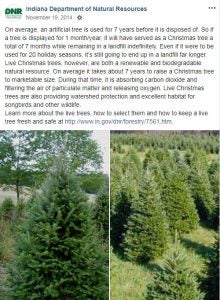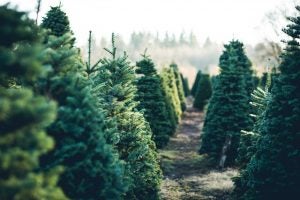One Thanksgiving, I caused a bit of a stir when someone asked me about a post I shared, by the Indiana Department of Natural Resources, that discussed the sustainability of real Christmas trees versus fake ones. The post stated that, on average, an artificial tree is used for seven years and then disposed of. On top of that, it stays in a landfill indefinitely. Real trees, by comparison, are “both a renewable and biodegradable natural resource,” according to the Indiana agency. It opened a conversation I never really considered because my family has both real and fake trees every year.

Of course, this isn’t meant to condemn anyone with artificial trees. It all comes down to preference, because, let’s be honest, there is a lot of efficiency and convenience with a fake tree. While the seven years mentioned above is an average, some artificial trees have been known to last for decades. For some folks, it’s also financially burdening to buy a tree every year (though some artificial brands, such as Balsam Hill, can run several hundreds of dollars, especially if you get them pre-strung with lights). Other families might not be able to haul a real tree home or want to dispose of it after its use.
Concerns about real trees include allergies that pets and humans might have to them, fire hazards from drying out, as well as dropping needles too soon.
So, there are many reasons why an artificial tree is a more sound decision for a family — but there is also little denying the sustainability of a real tree and its growing cycle.
On the same post by the Indiana Department of Natural Resources, they stated how it takes about seven years to grow a real tree. In this time, each of those trees are doing multiple things that benefit the environment, from absorbing carbon to providing watershed protection. An artificial tree, on the other hand, will be used only about one month a year during its lifetime. Fake trees can be recycled, but with multiple materials, like copper and PVC, there are challenges to recycling, and it’s more common they are placed in landfills. According to the National Christmas Tree Association, 80 percent of artificial trees worldwide are made in China and brought to the U.S., while real trees are grown locally, leaving a much smaller footprint than their counterparts.
Related article: The folklore behind Christmas trees
People have also made cutting down Christmas trees seem like a thing of the past, but the NCTA reports that 25 million to 30 million real trees are sold each year, and there are 350 million currently growing on Christmas tree farms. When you buy a tree from a grocery store parking lot or stand on the side of a road, they are probably trees that have been farmed for the specific purpose of being used for Christmas and aren’t chopped down from forests.
And, Christmas tree farms are doing so many wonderful things, from helping the local economy, improving the environment, providing a tourist attraction and preserving family traditions. Not only are these tree farms preserving land from further urban development, they are also turning otherwise unfarmable land into something beneficial, because many trees are grown in areas where crops aren’t suitable.

There are permits issued each year that do allow people to chop down their own trees on government land, but a limited number of permits are available. In California, for example, only two tags are available for purchase per permit/person/household. The USDA Forest Service allows this to help reduce hazardous fuel ladders and to remove smaller trees that are crowding the forest floor to create a healthier forest over time. There are hazards and tips on cutting down your own tree, so please be sure to check with your state’s requirements.
After you are done with your real tree, there are many ways to properly dispose of them in a sustainable way. The Indiana Department of Natural Resources suggests taking it to a recycling center, throwing it into your yard for wildlife (beware of fire hazards especially in California), or chopping it up for mulch or fire wood.
Fake or real, it’s important to know how to be as sustainable as possible, and regardless of which kind of tree you prefer, we can all agree that no one says they love the smell of plastic trees.
Markie Hageman lives in California and is an agribusiness graduate from Fort Hays State University. She is the Communications Coordinator for California Rangeland Trust and is an avid agriculture advocate. Her AGDAILY.com articles can be found here.



